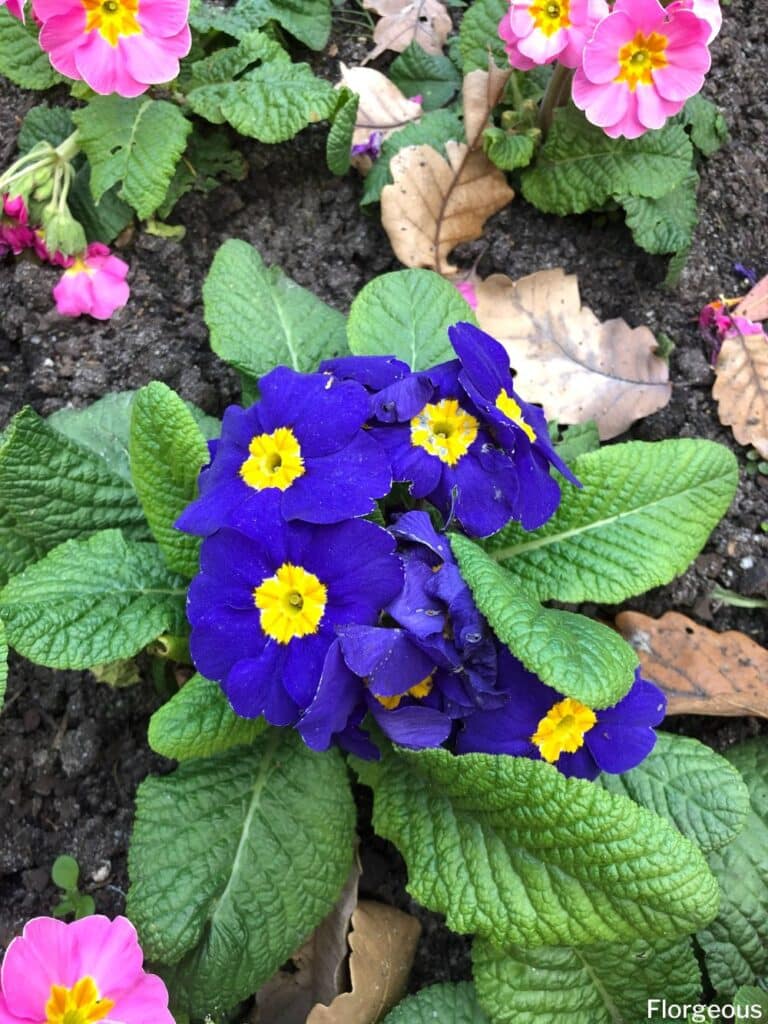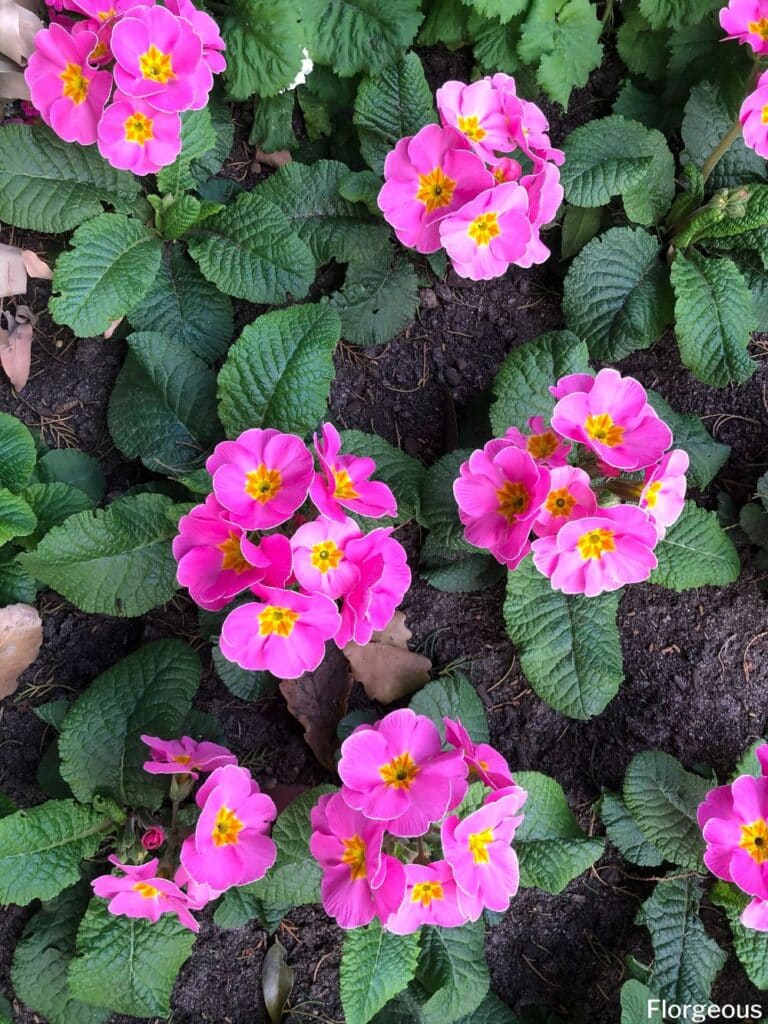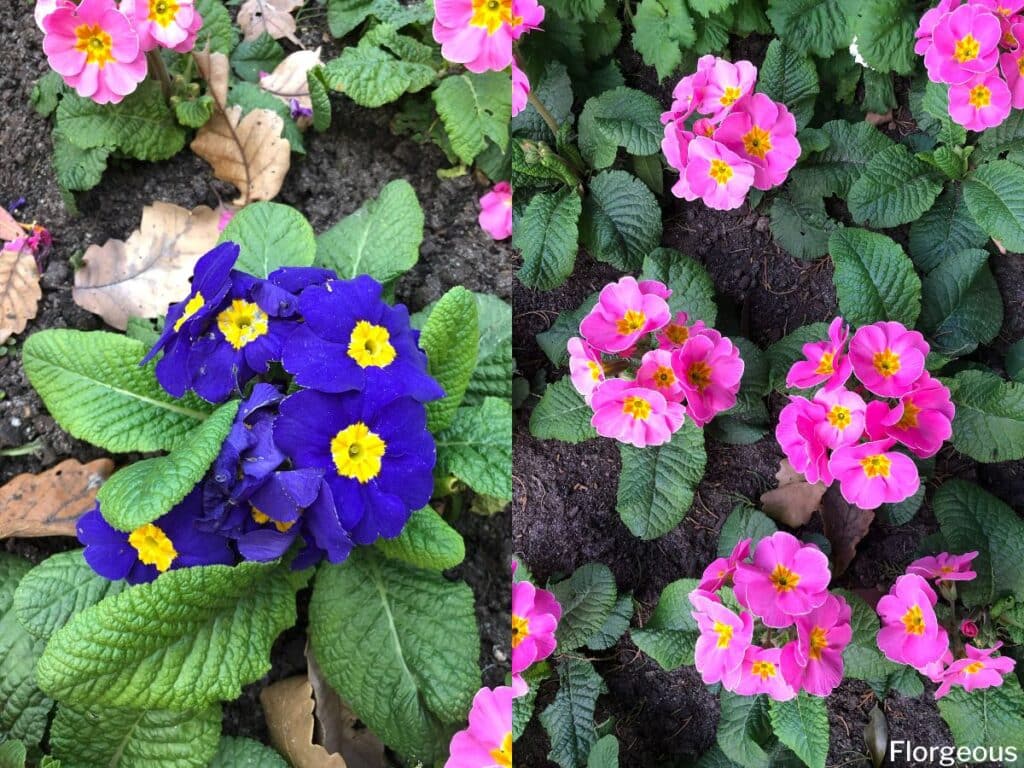Are you interested in growing primrose plants? Prepare to be spellbound as we unveil an astonishing array of primrose varieties, each boasting its own distinct charm and captivating presence.
Primroses and the Primula Genus
Primroses are from the Primula genus of the Primulaceae botanical family (1). These hardy plants produce clusters of beautiful flowers that bloom in early spring and last for weeks. They are native to Europe, Africa, and Asia (2).
The name primrose originated from the Latin words prima rosa, which means “first rose.”
Plant Description

Plants in the Primula genus are herbaceous perennials that may be evergreen or deciduous. Most primrose types are low-growing and feature basal rosette leaves that can be toothed or lobed.
Typically, garden-favorite primroses form branched clusters of flowers in various colors, including blue, purple, red, and yellow. Some varieties present a single bloom per stem, while others have a rounded flower head or flower spikes.
Individual primrose flowers are five-petaled and mostly funnel-shaped, but some varieties bear bell-shaped or pendant blooms instead. Both semi-double and double flower types are also available.
Uses
Primrose flowers present themselves to various uses in gardens and landscapes, herbal medicine, aromatherapy, and more.
The leaves and flowers of common primrose (P. vulgaris), in particular, are edible. Primrose tea and wine, which are known beverages, are byproducts of these plants’ leaves and flowers. Some people also cook and eat the leaves like vegetables.
The whole primrose plant, fresh and in bloom, and the dried roots also play a role in herbal medicine. Because of their many medicinal properties, individuals often use primroses as treatments against colds, headaches, muscular cramps, and as a sedative.

Evening Primrose (Oenothera biennis) vs Primrose (Primula vulgaris)
This article focuses on primrose which belongs to the Primulaceae family. Evening Primrose or common evening-primrose is a different plant that belongs to the Onagraceae family.
The evening primrose is commonly known for its seed oil that is used to make skincare products and medicine. Some people might confuse the two but they are two different plants.
Best Types and Varieties of Primroses to Grow in Your Garden
There are many garden flowers you can grow. When it comes to Primulaceae family, here are some popular choices:
Common Primrose (Primula vulgaris)
Cultivated worldwide are many different types of primrose, but one of the most prevalent is the common primrose or P. vulgaris. This species is known for its lightly fragrant, pale yellow flowers that bloom beautifully in spring. It is semi-evergreen and hardy (2). Each flower measures about 1 inch across, forming a cluster on a 6-inch stem atop a basal rosette of crinkled leaves (3).
This type of primrose is small, growing about 4 to 6 inches tall, but may spread 6 to 8 inches (2). They are hardy in USDA hardiness zones 4 to 8.
Japanese Primrose (P. japonica)

Japanese primrose, otherwise known as candelabra primrose or Primula japonica, is another popular type of primrose flowers. This Japan-native species grows to 12 inches in height and features a basal rosette of broad, crinkled leaves and beautiful whorls of blooms.
These primrose flowers come in shades of white, pink, purple, or red. Like the common primrose, Japanese primroses are hardy in USDA hardiness zones 4 to 8.
The ‘Miller’s Crimson’ is one of the many recognized cultivars of this primrose species. It is an early-blooming variety that flaunts a charming display of crimson flowers. The flowers have distinctive darker eyes and bloom in clusters.
Cherry Blossom Primrose (P. sieboldii)
Native to Northeast Asia, cherry blossom primrose, or Siebold primrose (P. sieboldii), presents 12-inch flower stalks that carry blooms in shades of cherry red, pink, lavender, or white (2).
The leaves are light green, oval, and feature scalloped edges. It grows best in USDA hardiness zones 3 to 8 and blooms in spring to early summer. The plant grows to 11 inches in height.
Popular cherry blossom primrose cultivars:
- ‘The Bride’
- ‘Mai-ogi’
- ‘Seraphim’
- ‘Blue Lagoon’
- ‘Sumizome Genji’
- ‘Frilly Blue’
- ‘Martin Nest Blue’
- ‘Kokoroiki’
- ‘Cherubim’
- ‘Sekidaiko’
- ‘Keepsakes’
Hardy Primrose (P. kisoana)
Hardy primrose (Primula kisoana) is a clump-forming herbaceous perennial that grows about 4 to 6 inches tall. Since it is a Japanese primrose type, this species also gained the name “Japanese primrose,” although it’s different from the P. japonica species.
It is as long-lived and vigorous as other primroses, but it is more tolerant of hot and dry summers. The hardy primrose plant is hardy in USDA hardiness zones 2 to 8. It features soft stems and attractive clusters of pink flowers.
Popular hardy primrose cultivars:
- ‘Alba’
- ‘Iyobeni’
- ‘Barnhaven Blush’
- ‘Kyroen’
Drumstick Primrose (P. denticulata)
Drumstick primrose or Primula denticulata is a primrose species that originate from the Himalayas. It is an early-bloomer type, showcasing mauve, lavender, or reddish-purple flower clusters that emerge from 15-inch stems.
Ideal for growing in USDA hardiness zones 2 to 8, the plant needs moist and fertile soil to thrive.
Popular drumstick primula cultivars:
- ‘Alba’
- ‘Blue Selection’
Bee’s Primrose (P. beesiana)
Bee’s Primrose or Primula beesiana is a purple-flowered type of primrose. Each flower features a yellow eye, giving this particular species a unique yet charming appeal. These primrose flowers bloom in late spring and early summer on top of erect stems.
The summer plant also features a flat rosette of light green, wrinkled leaves and grows up to about 20 inches in height.
Other common names of this type of primrose flowers include candelabra primrose, candelabra primula, and bog primula.
Cowslip Primrose (Primula veris)
One of the most common types of primroses is the cowslip primrose, otherwise known as cowslip or common cowslip. It features 1 to 2-inch fragrant blooms that come in vibrant shades of yellow. The flowers form into clusters atop 6 to 12 inches stems.
This species of primrose grows best in harsh, cold weather. It is hardy in USDA hardiness zones 4 to 8.
Common giant cowslip flowers are also known as English cowslip, bedlam cowslip, fairy cup, herb Peter, key flower, and keywort.
One of the most popular cultivated varieties of Primula veris is the ‘Sunset Shades’ cowslip primrose. Unlike most cowslip primroses, which are vibrant yellow, this particular variety features hints of orange and copper-red on the edges of each yellow petal.
Orchid Primrose
This is a type of primrose that is native to China. It grows best in partial shade and prefers moist, well-drained soil. This plant produces beautiful purple flowers with yellow centers. It blooms from late spring to early summer.
Primula vialii (Chinese Pagoda Primrose Plants)
These plants grow best in full sun or partial shade and prefer moist, well-drained soil. This plant produces clusters of pink or white flowers with yellow centers. It blooms from late spring to early summer.
Primula marginata
Primula marginata is a type of primrose that is native to Europe. It grows best in full sun or partial shade and prefers moist, well-drained soil.
This plant produces pink or white flowers with green margins. It blooms from late spring to early summer.
Primula bulleyana
Also known as Bulley Primrose, this is a type of primrose that is native to China. It grows best in full sun or partial shade and prefers moist, well-drained soil.
This plant produces clusters of blue or violet flowers with yellow centers. It blooms from late spring to early summer.
Primula pulverulenta (Powdery Primrose)
This is a type of primrose that is native to Europe. It grows best in full sun or partial shade and prefers moist, well-drained soil.
This plant produces clusters of pink or white flowers with powdery gray leaves. It blooms from late spring to early summer.
Primula florindae
Also known as the “Fairy Primrose” due to its delicate appearance, this type of primrose is native to the Himalayas and has bright pink or purple flowers that bloom from early spring until late summer. They thrive in moist soil and full sun, making them perfect for rock gardens or along pathways.
English Primrose
One of the most common varieties, English primroses have bright yellow or white flowers with five pointed petals and a yellow center.
They need cooler temperatures and partial shade, making them well suited for gardens in cooler climates. They will die back in winter but will return with new growth each spring.
Silver Edged Primrose
This species is similar to English primroses but has silver edging around their petals instead of yellow centers. It prefers slightly warmer temperatures than English primroses and needs more shade, making it ideal for gardens in areas with mild winters and hot summers.
They will go dormant in the winter but can be replanted each spring for continuous blooms throughout the year.
Gold Laced Primrose
These small flowers have gold edging around their petals and are a favorite among gardeners who want something different from traditional English primroses.
They prefer cooler temperatures and need partial shade, so they are best planted in gardens located in cooler climates with mild winters and hot summers. The foliage will die back in winter but will return each spring with new growth and vibrant blooms.
Round Headed Himalayan Primrose (Primula capitata)
This type of primrose is native to the Himalayas and has round shaped heads composed of many tiny pink or purple flowers that bloom from early spring until late summer time when they go dormant again during colder months.
This variety loves moist soil and full sun exposure so they make great additions to rock gardens or along pathways where they get plenty of sunlight throughout the day!
What Can I Plant with Primroses?
Primrose can tolerate some afternoon shade and prefers acidic soil. It can tolerate wet soil as long as it is relatively well drained soil. It is perfect for cottage gardens or for planting beneath a deciduous perennial tree.
Consider growing a few of these other flowers that love morning sun and moist soil with your primrose.
A fun fact is that primrose is a February Birth Flower, just like violet. So it makes sense to plant both of them together.
Here are some of our other recommended flowering companion plants to grow along with primroses.
- Violets
- Woodland phlox
- Wood poppy
- Crested iris
- Virginia bluebells
- Trilliums
- Twinleaf
- Bloodroot
- Dutchman’s breeches
- Ferns
Whether it’s Primula denticulata, Primula veris, or some other type of primrose flower that strikes your fancy, know this – these spring bulbs are perfect for planting in any setting. They produce fragrant flowers that can tolerate light shade and moist soil, and are perfect for rock gardens, containers, a woodland garden, and much more.
Learn more about primrose symbolism to see why people love these flowers and consider growing one of these beautiful flowers today!







